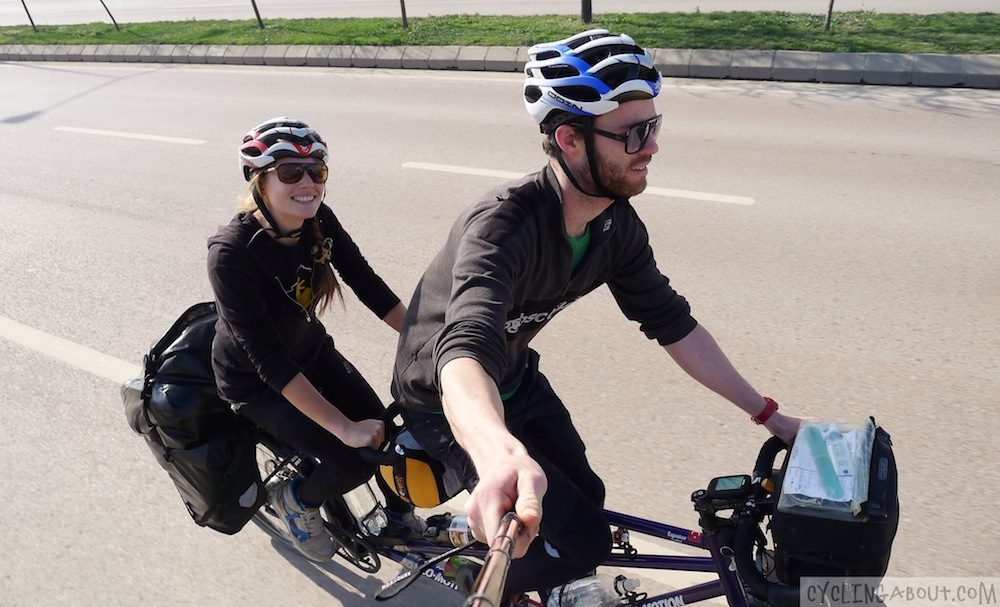Yes, you can go faster on a tandem bike with the help of synchronized pedaling. Tandem bikes are designed for two riders, allowing them to achieve higher speeds than a single rider.
The combined effort of two people pedaling in unison gives the tandem bike greater power and speed than a solo rider. This coordinated effort not only increases speed but also enhances the overall stability and control of the bike. The tandem bike’s unique design and the joint effort of both riders enable it to reach higher speeds compared to solo bikes.
Whether it’s for recreational cycling or competitive racing, tandem bikes offer an exhilarating and efficient way to travel at faster speeds.

Credit: www.cyclingabout.com
Benefits Of A Tandem Bike
Riding a tandem bike has numerous advantages. Not only does it provide a unique and enjoyable means of transportation, but it also offers various benefits that enhance the overall cycling experience. In this article, we will explore the improved speed and enhanced efficiency that can be achieved with a tandem bike.
Improved Speed
Riding a tandem bike allows you to go faster than with a traditional single-rider bicycle. This is due to the combined effort of two riders pedaling together in sync. With coordinated teamwork, the power generated from both riders’ pedal strokes is multiplied, resulting in faster speeds.
Enhanced Efficiency
One of the key advantages of riding a tandem bike is the improved efficiency it offers. With two riders working in harmony, the workload is shared, making it easier to maintain a consistent speed over long distances.
Factors Affecting Speed On A Tandem Bike
Boosting speed on a tandem bike relies on crucial factors. Rider synchronization, power distribution, and bike set-up impact performance. Coordinated efforts, proper technique, and equipment adjustments can contribute to achieving higher speeds on a tandem bike.
Physical Fitness
The physical fitness of riders plays a crucial role in determining the speed of a tandem bike.
Coordination
Effective coordination between riders is essential for maximizing speed and efficiency on a tandem bike.
Bike Design
The design of the tandem bike, including frame material and aerodynamics, can impact its speed capabilities.
Terrain Conditions
The terrain conditions, such as hills, road surface, and wind resistance, significantly affect the speed of a tandem bike.
When riders are in sync, physically fit, and equipped with a well-designed tandem bike, they can conquer various terrains for a faster and smoother ride.
Techniques To Increase Speed On A Tandem Bike
Riding a tandem bike can be an exhilarating experience, especially when you and your partner are striving to increase your speed. In this blog post, we’ll explore some proven techniques to help you go faster on a tandem bike. By mastering these strategies, you can enhance your riding performance and enjoy the thrill of increased speed. Let’s dive into the techniques that will boost your tandem biking experience.
Optimal Pedaling Cadence
Maintaining an optimal pedaling cadence is crucial for increasing speed on a tandem bike. To achieve this, both riders must synchronize their pedaling to find a consistent rhythm that maximizes power output. Aim for a cadence between 80-100 revolutions per minute (RPM) to ensure efficient energy transfer and propulsion.
Smooth And Synchronized Pedaling
Smooth and synchronized pedaling is essential for tandem riders to achieve optimal speed. By coordinating your pedaling strokes, you can minimize energy wastage and maintain a steady momentum. Focus on staying in sync with your partner to avoid unnecessary fluctuations in speed and power output.
Aerodynamic Positioning
Adopting an aerodynamic positioning can significantly reduce wind resistance and enhance your tandem bike’s speed. Keep your body low, elbows bent, and maintain a streamlined posture to minimize drag. When riding in a headwind, tuck in closely behind your partner to take advantage of the drafting effect and increase your overall speed.
Proper Gear Selection
Selecting the right gear based on the terrain and riding conditions is crucial for maximizing speed on a tandem bike. Anticipate changes in elevation and adjust your gears accordingly to maintain an efficient cadence. Communication between riders is key to ensuring smooth gear shifts and adapting to varying terrains without compromising speed.

Credit: www.earthridercycling.com
Training Tips For Faster Tandem Cycling
Riding a tandem bike can be a thrilling experience, especially when you and your partner work together to achieve greater speed and efficiency. To improve your tandem cycling performance, focusing on specific training techniques can make a significant difference. Whether you want to increase your strength, endurance, or hill climbing abilities, here are some training tips to help you go faster on a tandem bike.
Strength And Endurance Training
When training for faster tandem cycling, it’s important to focus on building strength and endurance. Incorporating weight training and cycling-specific exercises can help improve the power output of both riders. Additionally, including longer rides in your training regimen can enhance your endurance and overall cycling performance.
Interval Training
Interval training is crucial for improving your speed and power on a tandem bike. By alternating between intense bursts of cycling and active recovery, you can enhance your cardiovascular fitness and overall riding capacity. Implementing sprint intervals and threshold efforts during your training sessions will help you boost your tandem cycling performance.
Group Riding Skills
Mastering group riding skills is essential for achieving faster speeds on a tandem bike. Learning to communicate effectively with your partner, maintain proper cadence and synchronization, and navigate tight formations can significantly improve your tandem cycling efficiency. Additionally, practicing drafting techniques within a group can help reduce wind resistance and enhance your overall speed.
Hill Climbing Techniques
Improving your hill-climbing techniques is crucial for conquering inclines and elevating your tandem cycling speed. Focusing on gear selection, maintaining a steady cadence, and utilizing powerful pedal strokes can help you efficiently tackle challenging climbs. Incorporating specific hill repeat workouts into your training routine can also help you build the necessary strength and endurance for uphill riding.
Common Challenges Of Riding A Tandem Bike At High Speeds
Riding a tandem bike at high speeds presents challenges due to synchronization issues, weight distribution, and the need for strong communication between riders. Coordinating movements and balance becomes crucial for achieving faster speeds on tandem bikes.
Loss Of Control
Riding a tandem bike at high speeds can lead to sudden loss of control, particularly when maneuvering through obstacles or changing directions quickly. Balancing the weight of two riders becomes crucial to maintain stability.
Braking Issues
Braking on a tandem bike, especially at high speeds, can be challenging due to the added momentum of two riders. Coordinating braking efforts and applying equal pressure on the brakes is essential to avoid skidding or accidents.
Navigating Turns
Navigating sharp turns at high speeds on a tandem bike requires precise communication between the riders. Coordinating leaning angles and counterbalancing to prevent tipping is vital for maintaining control.
Managing Different Fitness Levels
Differences in fitness levels between tandem riders can pose a challenge when riding at high speeds. Adjusting pedaling cadence and communicating effectively are key to ensure a smooth ride for both riders.
Credit: www.triathlete.com
Safety Precautions On A Tandem Bike
When riding a tandem bike, it is important to adhere to safety precautions to prevent accidents and injuries. However, the speed at which you can go on a tandem bike depends on several factors such as the experience level of the riders, terrain conditions, and the bike’s capabilities.
It is essential to maintain proper communication, balance, and coordination with your partner while riding to ensure a safe and enjoyable experience.
Communication And Trust
Communication and trust are crucial when riding a tandem bike to ensure a safe and enjoyable experience. As both riders are connected on the same bike, it is essential to communicate effectively to coordinate your movements and react to any potential hazards. Good communication allows for smoother rides and better handling of the bike.
- Speak up: Use your voice to communicate intentions, such as when you intend to start pedaling, slow down, or stop. Clear verbal instructions help maintain a synchronized rhythm and prevent any abrupt movements that may compromise stability.
- Hand signals: In addition to verbal communication, utilize hand signals to indicate upcoming turns or hazards on the road. This allows your partner to anticipate and adjust their balance accordingly.
- Trust your partner: When riding a tandem bike, it’s essential to trust your partner’s ability to handle the bike. Avoid sudden movements or second-guessing their decisions, as this can lead to unwanted instability on the bike. Trust in each other’s skills ensures a safer and more enjoyable ride.
Proper Braking Technique
Understanding and implementing proper braking techniques is essential for maintaining control and ensuring the safety of both riders on a tandem bike. Follow these guidelines to brake effectively:
- Coordinate with your partner: Before braking, communicate your intention, allowing your partner to prepare for the change in speed.
- Apply even pressure: Apply the brakes smoothly and evenly, avoiding sudden or excessive force that could destabilize the bike. Gradual braking is safer and more comfortable for both riders.
- Use both brakes: Utilize both the front and rear brakes to evenly distribute the braking force. Applying only the front or rear brake can lead to instability or loss of control.
- Maintain control: Keep a firm grip on the handlebars when braking to maintain stability. Avoid locking the wheels to prevent skidding.
Appropriate Helmet Use
Wearing helmets is essential for the safety of both riders on a tandem bike. Take these guidelines into account for appropriate helmet use:
- Wear a well-fitting helmet: Make sure the helmet fits snugly on your head without any looseness or wobbling. It should sit level and cover the top of your forehead.
- Secure the chinstrap: Fasten the chinstrap securely to prevent the helmet from shifting or falling off during the ride.
- Replace damaged helmets: If your helmet has been involved in an accident or shows signs of wear, replace it with a new one. Damaged helmets may not provide adequate protection in the event of a fall or collision.
Regular Bike Maintenance
Regular bike maintenance is crucial to ensure the safety and performance of your tandem bike. Adhere to these maintenance practices:
- Check tire pressure: Maintain the appropriate tire pressure for a smooth and comfortable ride. Underinflated or overinflated tires can affect stability and handling.
- Inspect brakes: Regularly check the brake pads for any signs of wear and adjust or replace them as necessary. Well-functioning brakes are essential for safe stopping.
- Keep the chain lubricated: Apply chain lubricant regularly to ensure smooth and efficient pedaling. A dry or dirty chain can cause poor performance and even lead to accidents.
- Inspect the frame and components: Regularly inspect the frame, handlebars, pedals, and other components for any signs of cracks, looseness, or wear. Address any issues promptly to prevent mechanical failures while riding.
Tandem Bike Racing
Discover the thrill of tandem bike racing and unleash your speed potential. Two riders working in sync can achieve higher speeds and conquer racing challenges like never before. Experience the camaraderie and adrenaline rush of going faster on a tandem bike.
Introduction To Tandem Bike Racing
Tandem bike racing, also known as tandem cycling, is a thrilling and exhilarating sport that involves two riders working together on a single bicycle. Unlike traditional bike racing, where a single rider propels the bike forward, tandem racing relies on the coordination and synchronization of both riders to achieve maximum speed and efficiency.
Types Of Tandem Racing
Tandem bike racing encompasses various types of events that cater to different skill levels and preferences. The most common types of tandem racing include:
- Time Trial: In this race format, teams of two compete against the clock, aiming to complete the course in the shortest time possible. Time trials require a combination of speed, endurance, and strategic teamwork.
- Track Racing: Taking place on a velodrome, track racing tests the riders’ ability to navigate tight corners and sprint at high speeds. With short distances and intense competition, track racing is a thrilling spectacle for both riders and spectators.
- Road Racing: Similar to traditional road bike races, tandem road racing involves teams of two competing over long distances on public roads. Riders must navigate different terrains and work together to outpace their competitors.
- Para-cycling: Tandem racing in paralympic events allows visually impaired athletes to participate in the sport. One rider acts as a pilot, providing guidance and navigation, while the other rider focuses on generating power and speed.
- Criterium: Criterium races are held on closed-loop circuits, usually in urban settings. Riders race multiple laps around the course, sprinting for points at designated intervals. The fast-paced nature of criterium racing demands agility and quick decision-making.
Training Strategies For Tandem Racing
Training for tandem bike racing requires a combination of individual and team-focused exercises. Here are some effective training strategies to enhance your performance as a tandem racing duo:
- Communication is Key: Establish clear and concise communication with your partner to coordinate your efforts. Use verbal cues, hand signals, and even non-verbal communication to stay in sync during races.
- Strength and Endurance Training: Develop strong legs and cardiovascular fitness through regular strength and endurance workouts. Focus on exercises such as interval training, hill climbs, and squats to build power and stamina.
- Practice Cornering and Maneuvering: Mastering the art of cornering and bike handling is vital in tandem racing. Find a safe area to practice sharp turns, tight maneuvers, and quick accelerations to improve your bike handling skills.
- Team Time Trials: Regularly perform team time trial sessions to improve your coordination and synchronization as a tandem racing duo. Work on maintaining a steady pace, smooth transitions, and optimal positioning on the bike.
- Tactical Strategies: Discuss and strategize with your partner on race tactics, such as when to attack, when to conserve energy, and how to best position yourselves within a peloton or breakaway group.
Competitive Tandem Bike Events
Tandem bike racing events provide exciting opportunities for riders to showcase their skills and compete against the best in the sport. Some of the most prestigious competitive tandem bike events include:
| Event | Location | Description |
|---|---|---|
| UCI Para-cycling World Championships | Various Locations | An international event featuring para-cyclists from around the world in various tandem racing categories. |
| Tandem Race Across America (RAAM) | United States | A grueling endurance race where tandem teams traverse the entire width of the United States, covering approximately 3000 miles. |
| European Tandem Tour | Europe | A multi-day tour where tandem enthusiasts ride through scenic routes in Europe, enjoying camaraderie and the beauty of nature. |
These events provide a platform for tandem cyclists to push their limits, gain recognition, and inspire others to join the exciting world of tandem bike racing.
Frequently Asked Questions Of Can You Go Faster On A Tandem Bike
What Are The Disadvantages Of Tandem Bikes?
Disadvantages of tandem bikes include potential balance issues, coordination needed, limited maneuverability, and difficulty communicating with your partner.
Do You Have To Pedal At The Same Speed On A Tandem Bike?
No, riders do not have to pedal at the same speed on a tandem bike. They can pedal at different speeds according to their comfort and strength.
Is It Hard To Ride A Tandem Bike Alone?
Riding a tandem bike alone can be challenging due to its longer length and different handling. It requires good balance and control. However, with practice and adjusting the seat, it’s possible to ride alone. It’s important to start slowly and get comfortable with the handling.
Does The Type Of Bike Affect Speed?
Yes, the type of bike can affect speed due to factors like weight, aerodynamics, and efficiency.
Conclusion
So, can you increase speed while riding a tandem? Absolutely! Communication and coordination are key. Practice together to optimize performance. Tandem biking promotes teamwork and shared experiences. Embrace the challenge and enjoy the journey! Strengthen your bond while pedaling faster on a tandem bike.



